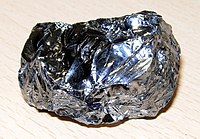
Photo from wikipedia
DOI: 10.1002/adom.202001721 performance of on-chip components for silicon photonics.[1–5] For ultrafast optical switching, VO2 has long been viewed as a promising candidate for integration with silicon photonics components. However, while… Click to show full abstract
DOI: 10.1002/adom.202001721 performance of on-chip components for silicon photonics.[1–5] For ultrafast optical switching, VO2 has long been viewed as a promising candidate for integration with silicon photonics components. However, while experiments during the last decade have shown that VO2 thin films can be optically switched from the insulating to the metallic state and then recover on a picosecond time scale at low pump fluences,[6–8] most experiments were carried out at pump wavelengths near 800 nm, and none directly incorporated VO2 into a silicon waveguide. Moreover, ultrafast electron-diffraction studies comparing the photo-induced phase transition (PIPT) using near band-edge (2000 nm) excitation versus 800 nm pumping showed that the former requires half the enthalpy change of the latter,[8] consistent with the observed monotonic decrease in PIPT threshold as the pump-laser photon energy approaches the VO2 band edge and suggesting that the transition can be driven in a low-fluence, athermal regime.[9] Hence, while prior work provides a rationale for integrating VO2 into Si photonic components,[10–13] there is still no direct evidence that a femtosecond optical pulse at telecommunication frequencies traversing a hybrid VO2:Si waveguide can be switched on and off at ultrafast time scales, less than 1 ps. The incorporation of VO2 into silicon waveguide geometries is relatively recent. The transmission modulation of a continuous-wave (CW) signal by heating a Si ring-resonator with a VO2 patch on a small section of the ring first demonstrated the feasibility of using VO2 as the active material on a silicon photonic component; while the steady-stating heating carried out in this experiment did not allow investigation of response time, a modulation depth exceeding 6 dB was shown.[10] Nanosecond all-optical switching of a CW laser beam at 1550 nm in both inline Si waveguide modulators and ring resonators subsequently showed that the response time of VO2 incorporated atop these silicon photonic components could track the pulse width of the 1064 nm out-of-plane nanosecond pump laser.[12] Most recently, optical switching of a CW 1550 nm signal beam in Si3N4 dual waveguides covered with a thin film of VO2, by 140 fs pulses from an 80 MHz Ti:Sapphire oscillator at wavelengths between 800 to 1000 nm, demonstrated the feasibility of using an in-plane all-optical pumping scheme with pJ threshold switching energy; however, the “on-off” switching time was not measured.[14] Here, we take a significant step forward in establishing the feasibility of Tbps on-chip optical switching using hybrid VO2:Si Hybrid material systems are a promising approach for extending the capabilities of silicon photonics. Given the weak electro-optic and thermo-optic effects in silicon, there is intense interest in integrating an ultrafast-switching phase-change material with a large refractive index contrast into the waveguide, such as vanadium dioxide (VO2). It is well established that the phase transition in VO2 thin films can be triggered by ultrafast, 800 nm laser pulses, and that pump-laser fluence is a critical determinant of the recovery time of thin films irradiated by femtosecond pulses. However, thin-film experiments are not reliable guides to a VO2:Si system for all-optical, on-chip switching because of the differences in VO2 optical constants in the telecommunication band, and the complex sample geometry and alignment issues in a waveguide geometry. This paper reports the first demonstration that the reversible, ultrafast photoinduced phase transition in VO2 can achieve sub-picosecond response when small VO2 volumes are integrated into a silicon waveguide as the active element. The result suggests that VO2 can be pursued as a strong candidate for waveguide switching with sub-picosecond on-off times.
Journal Title: Advanced Optical Materials
Year Published: 2020
Link to full text (if available)
Share on Social Media: Sign Up to like & get
recommendations!